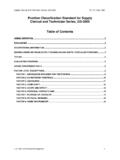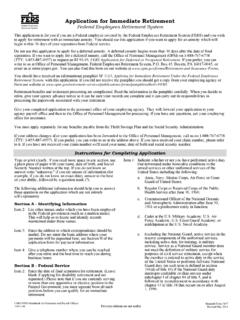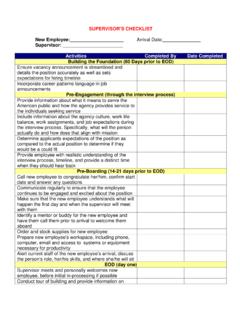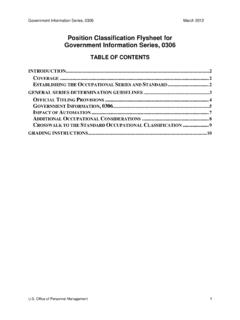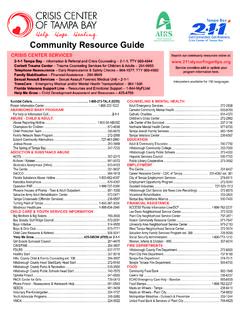Transcription of 360-Degree Assessment - United States Office of Personnel ...
1 United StatesPerformanceOffice ofManagementPersonnel and IncentiveManagementAwards Division360-DegreeAssessment:An OverviewThis material was developed with the assistance ofHuman Technology, Inc. of McLean, VA, under contractOPM-91-2958 with the Office of Personnel Mangement sTraining Assistance Assessment : An OverviewTABLE OF 2 What does this rating source contribute?.. 2 What cautions should be addressed?.. 3 What does this rating source contribute?.. 3 What cautions should be addressed?.. 4 What does this rating source contribute?.. 4 What cautions should be addressed?.. 6 What does this rating source contribute?.. 6 What cautions should be addressed?.. 7 What does this rating source contribute?.. 8 What cautions should be addressed?.. 8 Questions & 9360 DEGREE ASSESSMENTUSOPM:PMIADS eptember 1997 Page 1C ONCEPTT ypically, performance appraisal has been limited to a feedback process between employees andsupervisors.
2 However, with the increased focus on teamwork, employee development, andcustomer service, the emphasis has shifted to employee feedback from the full circle of sourcesdepicted in the diagram below. This multiple-input approach to performance feedback is sometimescalled 360-Degree Assessment to connote that full are no prohibitions in law or regulationagainst using a variety of rating sources, in additionto the employee s supervisor, for assessingperformance. Research has shown assessmentapproaches with multiple rating sources providemore accurate, reliable, and credible information. For this reason, the Office of PersonnelManagement supports the use of multiplerating sources as an effective method of assessingperformance for formal appraisal and otherevaluative and developmental circle, or perhaps more accurately the sphere, offeedback sources consists of supervisors,peers, subordinates, customers, and one s self.
3 It is not necessary, or always appropriate, to include all of the feedback sources in a particularappraisal program. The organizational culture and mission must be considered, and the purposeof feedback will differ with each source. For example, subordinate assessments of a supervisor sperformance can provide valuable developmental guidance, peer feedback can be the heart ofexcellence in teamwork, and customer service feedback focuses on the quality of the team s oragency s results. The objectives of performance appraisal and the particular aspects of performancethat are to be assessed must be established before determining which sources are following pages discuss the contributions of each source of ratings and feedback. In addition,precautions are listed to consider when designing a performance management program that includes360-degree DEGREE ASSESSMENTUSOPM:PMIADS eptember 1997 Page 2 SOURCES Evaluations by superiors are the most traditional source of employee form of evaluation includes both the ratings of individuals by supervisorson elements in an employee s performance plan and the evaluation of programs and teams by seniormanagers.
4 What does this rating source contribute? The first-line supervisor is often in the best position to effectively carry out the full cycle ofperformance management: Planning, Monitoring, Developing, Appraising, and supervisor may also have the broadest perspective on the work requirements and be ableto take into account shifts in those requirements. The superiors (both the first-line supervisor and the senior managers) have the authority toredesign and reassign an employee s work based on their Assessment of individual and teamperformance. Most Federal employees (about 90 percent in a large, Governmentwide survey1) feel that thegreatest contribution to their performance feedback should come from their first-level cautions should be addressed? Research demonstrates that appraisal programs that rely solely on the ratings of superiors areless reliable and valid than programs that use a variety of other rating sources to supplementthe supervisor s evaluation.
5 Superiors should be able to observe and measure all facets of the work to make a fairevaluation. In some work situations, the supervisor or rating official is not in the samelocation or is supervising very large numbers of employees and does not have detailedknowledge of each employee s performance. Supervisors need training on how to conduct performance appraisals. They should be capableof coaching and developing employees as well as planning and evaluating their performance. 1 Survey of Federal Employees, USOPM, May DEGREE ASSESSMENTUSOPM:PMIADS eptember 1997 Page 3 This form of performance information is actually quite common but usuallyused only as an informal part of the supervisor-employee appraisal feedbacksession. Supervisors frequently open the discussion with: How do you feelyou have performed? In a somewhat more formal approach, supervisors ask employees to identify the keyaccomplishments they feel best represent their performance in critical and non-critical performance a 360-Degree approach, if self-ratings are going to be included, structured forms and formal procedures does this rating source contribute?
6 The most significant contribution of self-ratings is the improved communication betweensupervisors and subordinates that results. Self-ratings are particularly useful if the entire cycle of performance management involves theemployee in a self- Assessment . For example, the employee should keep notes of taskaccomplishments and failures throughout the performance monitoring period. The developmental focus of self- Assessment is a key factor. The self- Assessment instrument(in a paper or computer software format) should be structured around the performance plan,but can emphasize training needs and the potential for the employee to advance in theorganization. The value of self-ratings is widely accepted. Approximately half of the Federal employees ina large survey2 felt that self-ratings would contribute to a great or very great extent to fairand well-rounded performance appraisal. (Of the survey respondents who received ratingsbelow Fully Successful, over 75 percent felt self-ratings should be used.)
7 Self-appraisals should not simply be viewed as a comparative or validation process, but as acritical source of performance information. Self-appraisals are particularly valuable insituations where the supervisor cannot readily observe the work behaviors and task cautions should be addressed? Research shows low correlations between self-ratings and all other sources of ratings,particularly supervisor ratings. The self-ratings tend to be consistently higher. Thisdiscrepancy can lead to defensiveness and alienation if supervisors do not use good feedbackskills. 2 Survey of Federal Employees, USOPM, May DEGREE ASSESSMENTUSOPM:PMIADS eptember 1997 Page 4 (Continued)What cautions should be addressed? (Continued) Sometimes self-ratings can be lower than others . In such situations, employees tend to beself-demeaning and may feel intimidated and put on the spot. Self-ratings should focus on the appraisal of performance elements, not on the summary leveldetermination.
8 A range of rating sources, including the self-assessments, help to round out the information for the summary downsizing and reduced hierarchies in organizations, as well as the increasing useof teams and group accountability, peers are often the most relevant evaluators of theircolleagues performance. Peers have a unique perspective on a co-worker s job performance andemployees are generally very receptive to the concept of rating each other. Peer ratings can be usedwhen the employee s expertise is known or the performance and results can be observed. Thereare both significant contributions and serious pitfalls that must be carefully considered beforeincluding this type of feedback in a multifaceted appraisal does this rating source contribute? Peer influence through peer approval and peer pressure is often more effective than thetraditional emphasis to please the boss. Employees report resentment when they believe thattheir extra efforts are required to make the boss look good as opposed to meeting the unit sgoals.
9 Peer ratings have proven to be excellent predictors of future performance. Therefore, they areparticularly useful as input for employee development. Peer ratings are remarkably valid and reliable in rating behaviors and manner ofperformance, but may be limited in rating outcomes that often require the perspective of thesupervisor. The use of multiple raters in the peer dimension of 360-Degree Assessment programs tends toaverage out the possible biases of any one member of the group of raters. (Some agencieseliminate the highest and lowest ratings and average the rest.)SELF-ASSESSMENTPEERS360 DEGREE ASSESSMENTUSOPM:PMIADS eptember 1997 Page 5 (Continued)What does this rating source contribute? (Continued) The increased use of self-directed teams makes the contribution of peer evaluations the centralinput to the formal appraisal because by definition the supervisor is not directly involved inthe day-to-day activities of the team. The addition of peer feedback can help move the supervisor into a coaching role rather thana purely judging cautions should be addressed?
10 Peer evaluations are almost always appropriate for developmental purposes, but attempting toemphasize them for pay, promotion, or job retention purposes ( , the rating of record) may notbe prudent. The possible exception is in an award program as opposed to performance input can be effectively used for recognition and awards. There is a difference of opinion about the need for anonymity of the peer evaluators. Generally,it is advised that the identities of the raters be kept confidential to assure honest feedback. However, in close-knit teams that have matured to a point where open communication is part ofthe culture, the developmental potential of the feedback is enhanced when the evaluatoris identified and can perform a coaching or continuing feedback role. It is essential that the peer evaluators be very familiar with the team member s tasks andresponsibilities. In cross-functional teams, this knowledge requirement may be a problem.




